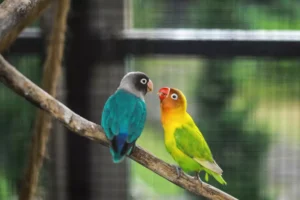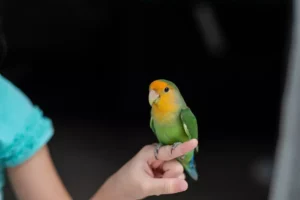Training your lovebird can be a fun and rewarding experience for both you and your bird. Lovebirds are intelligent birds and can learn a variety of tricks and behaviors.
With patience and positive reinforcement, you can teach your lovebird to do everything from flying to you when called, to speaking simple words or phrases.
- Start by teaching your lovebird simple tricks, like flying to you or perching on your finger
- As your bird becomes more comfortable with you, he will be more likely to want to please you
- Give your bird plenty of toys and things to do so that he doesn’t get bored
- A bored bird is a destructive bird, and you don’t want him tearing up your home out of frustration
- Train your bird regularly, but don’t overdo it
- A few short training sessions each day are better than one long one
- Be patient and consistent with your lovebird
- Like all animals, they respond best to positive reinforcement rather than negative punishment

Is Lovebird Easy to Train?
Lovebirds are a type of parrot, and like all parrots, they can be difficult to train. However, with patience and consistency, it is possible to teach your lovebird some simple tricks. Some people even train their lovebirds to do more complex behaviors, such as flying to a specific person or place on cue.
The best way to start training your lovebird is with positive reinforcement. This means rewarding your bird every time it performs the desired behavior.
For example, if you want your lovebird to step up onto your finger, you would give it a treat every time it does so. Soon, your bird will learn that stepping up leads to good things happening (getting treats!) and will be more likely to do it when you ask.
Another important thing to remember when training your lovebird is that birds are very smart creatures and can quickly figure out what you’re trying to get them to do.
As such, it’s important not to get frustrated or angry if your bird doesn’t seem to be catching on right away – just keep working at it, and eventually you’ll get there!
What is the Fastest Way to Tame a Lovebird?
There is no definitive answer to this question, as the best way to tame a lovebird will vary depending on the individual bird’s personality and preferences.
However, some tips on how to successfully tame a lovebird may include spending time with the bird every day, offering it treats, and talking or singing to it in a soft, calming voice.
It is also essential to avoid being too forceful or aggressive when handling the bird, as this could make it more difficult to tame.
What Tricks Can You Teach a Lovebird?
There are a variety of tricks that you can teach your lovebird, depending on its personality and preferences. Some common tricks include: –
- perching on your finger or shoulder
- stepping up onto a hand or stick
- flying to you when called
- doing simple flips or acrobatics in the air
playing dead With patience and positive reinforcement, almost any trick is possible. The key is to start small and build up gradually.
For example, if you want your lovebird to fly to you, begin by holding out your arm and rewarding it with a treat when it comes close.
Eventually, you’ll be able to call it from across the room. Flips and other aerial maneuvers are often easier to train for if you use a target – hold out a dowel or other object for your bird to land on, and give it a treat when it hits the mark.
As with all training, consistency is important – try to practice for short sessions several times a day for the best results.

How Do You Train Your Lovebird to Like You?
To train your lovebird to like you, it is important to establish a bond with the bird. This can be done by spending time together every day, talking to the bird, and offering it treats.
It is also important to provide the bird with plenty of toys and perches so that it has a comfortable environment.
Once a bond is established, you can begin teaching the bird tricks such as flying to your shoulder or stepping up onto your finger. These activities will help strengthen the bond between you and your lovebird.
How to Train a Lovebird to Talk?
One of the most popular questions we get here at The Lovebird House is how to train a lovebird to talk. While some people are born gifted vocalists, others require a little more work to get started.
However, with patience and consistency, even the quietest bird can learn to speak up!
Here are a few tips to help you get started:
- Start with simple words and phrases. “Hello,” “come here,” and “good bird” are all great places to start. If your lovebird responds well to these basic commands, you can begin adding more words to its repertoire. Just be sure not to overwhelm them and take things one step at a time.
- Use positive reinforcement when your lovebird says something correctly. This could include offering them a treat or verbal praise – whatever gets their attention and encourages them to keep going!
- Be patient! Some birds learn quickly while others need more time, but eventually, they’ll get there as long as you’re consistent with your training sessions.
Conclusion
If you’re thinking of adding a lovebird to your family, congratulations! These lively little parrots make wonderful pets. They are affectionate and playful, and they bond easily with their human companions.
The first step in training your lovebird is to establish trust. Spend time each day sitting near your bird’s cage and talking to him or her in a soft, gentle voice.
Once your bird feels comfortable around you, he or she will be more receptive to training.
One of the most important things you can teach your lovebird is how to perch on your finger.
This will help prevent bites and scratches, and it will also make it easier for you to handle your bird during grooming and vet visits.
To train your bird to perch on your finger, start by offering him or her a treat while you hold out your finger.
Once your bird steps onto your finger, give him or her the treat and plenty of praise. With patience and practice, your bird will learn that perching on your finger is a good thing!
Other behaviors that you can train your lovebird include: flying back to his or her cage when called; stepping up onto a stick or other object; playing fetch; learning simple tricks like waving hello or giving kisses; and speaking basic words or phrases.
The possibilities are endless, have fun exploring all the different ways you can interact with your feathered friend!